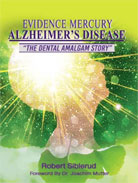
 |
Evidence Mercury Causes Alzheimer’s Disease: “The Dental Amalgam Story”
by Robert Siblerud
Global Summit House
Author Siblerud expresses a well-founded concern regarding the use of mercury, a pervasive poison, in dental amalgams used to fill cavities. The dangers of mercury have been well proven; the World Health Organization (WHO) declared that “there is no safe level of mercury” and established that human intake of this toxic element mostly stems from the amalgams still being used by most dentists. With new findings pointing to mercury poisoning as a significant factor in the development of Alzheimer’s disease (AD), the author examines in detail the stages and symptoms of AD, noting that many of them can be attributed to mercury poisoning, which begins immediately when a filling is inserted and increases over many years. A child who gets cavities filled with this amalgam is already in danger of becoming a victim of AD because mercury’s vapors will gradually and effectively cloud the brain.
At the outset of the use of mercury in 1839, strong objections were raised and have been recurring periodically up to the present. With a plethora of scientific studies supporting Siblerud’s concerns, he concludes this dynamic treatise by offering pragmatic, preventive factors to reduce the risks and rigors of AD, including having dental amalgams removed when possible.
Siblerud, a respected writer on related subject matter, brings to the themes presented here his impressive background in academic and independent study. On a personal note, he recalls his discouragement at resistance to his findings among many medical and scientific sources. Bolstering his wide-ranging investigation regarding mercury’s toxicity, he offers comprehensive appendices, including results from a major health survey of participants with and without amalgam. Siblerud’s assiduous exploration is offered in hopes that the substantiation presented will evoke serious efforts to ameliorate and eradicate physical and mental suffering through the elimination of mercury in dentistry.